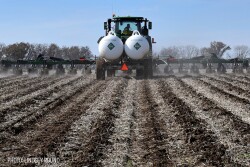Fertilizer
Going into the final weeks of the year, many growers across the country are shouldering significant financial strain from land rent payments, rising input costs, and efforts to stay in business and viable until commodity prices improve.
At a fiery Senate hearing, farmers and lawmakers call out corporate consolidation for driving up input costs, while industry leaders insist global geopolitics, not greed, are to blame.
As fertilizer prices and demand hold firm this fall, Josh Linville with Stone X Group warns prices could climb higher if reported government aid payments arrive this year.
Use one or more of these tips to reduce expenses, reallocate resources and build a fertility program that works well for your farm and gives you some peace of mind in the process.
As farmers think about 2026 cropping plans, step one is to book fall fertilizer. However, those plans are leading to challenging discussions about profitability and what can be applied as a bare minimum.
High yields lead to high nutrient removal rates, but next year, nutrient replacement and feeding a new crop comes at a higher cost
NCGA’s Krista Swanson says it would take about 226 bu. of corn to buy a ton of ammonium phosphate, which is up from the 180 bu. it took at the beginning of this year. As fertilizer costs are on the rise, corn prices are now at or below $4, and it’s creating a grim outlook for 2026.
Two global factors could break the trend, while a focus on efficiency could bring short-term opportunities for farmers
Veronia Nigh, economist at The Fertilizer Institute, says there are three key drivers in fertilizer right now.









